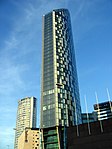Liverpool Royal Institution

The Liverpool Royal Institution was a learned society set up in 1814 for "the Promotion of Literature, Science and the Arts". William Corrie, William Rathbone IV, Thomas Stewart Traill and William Roscoe were among the founders. It was sometimes called the Royal Society of Liverpool. A royal charter was granted in 1821. The institute purchased a building on Colquitt Street where a lecture program was started. It also included an art gallery which hosted John James Audubon's first European exhibition, in 1826. A new building to host the gallery was built in 1841 and its director was William John Swainson. A grammar school for boys, the Royal Institution School, ran until 1892. After the construction of the William Brown Library and Museum, and Walker Art Gallery the institute fell into decline, its collections were moved to the gallery and its archives moved to University College Liverpool. The institute was dissolved in 1948.
Excerpt from the Wikipedia article Liverpool Royal Institution (License: CC BY-SA 3.0, Authors, Images).Liverpool Royal Institution
Queensway, Liverpool Vauxhall
Geographical coordinates (GPS) Address Nearby Places Show on map
Geographical coordinates (GPS)
| Latitude | Longitude |
|---|---|
| N 53.407805555556 ° | E -2.98925 ° |
Address
Moorfields
Queensway
L2 2HT Liverpool, Vauxhall
England, United Kingdom
Open on Google Maps




